| Listing 1 - 10 of 11 | << page >> |
Sort by
|
Book
ISBN: 9781800084353 Year: 2022 Publisher: [Place of publication not identified] : UCL Press,
Abstract | Keywords | Export | Availability | Bookmark
 Loading...
Loading...Choose an application
- Reference Manager
- EndNote
- RefWorks (Direct export to RefWorks)
The Chapel of St Peter-on-the-Wall, built on the ruins of a Roman fort, dates from the mid-seventh century and is one of the oldest largely intact churches in England. It stands in splendid isolation on the shoreline at the mouth of the Blackwater Estuary in Essex, where the land meets and interpenetrates with the sea and the sky. This book brings together contributors from across the arts, humanities, and social sciences to uncover the premodern contexts and modern resonances of this medieval building and its landscape setting. In analyzing the significance of the chapel and surrounding landscape over more than a thousand years, this collection additionally contributes to wider debates about the relationship between space and place, and particularly the interfaces between both medieval and modern cultures and also heritage and the natural environment.
England --- Essex (England) --- Essex, Eng. --- County of Essex (England) --- Social life and customs --- Antiquities.
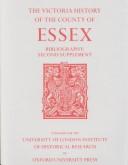
ISBN: 0197227945 9780197227947 Year: 2000 Publisher: Oxford Oxford university press
Abstract | Keywords | Export | Availability | Bookmark
 Loading...
Loading...Choose an application
- Reference Manager
- EndNote
- RefWorks (Direct export to RefWorks)
Book
ISBN: 1407356747 9781407356747 Year: 2020 Publisher: Oxford BAR Publishing
Abstract | Keywords | Export | Availability | Bookmark
 Loading...
Loading...Choose an application
- Reference Manager
- EndNote
- RefWorks (Direct export to RefWorks)
Anglo-Saxons --- Bronze age --- Excavations (Archaeology) --- Essex (England) --- Antiquities. --- Essex, Eng. --- County of Essex (England) --- Saxons --- Civilization --- Archaeological digs --- Archaeological excavations --- Digs (Archaeology) --- Excavation sites (Archaeology) --- Ruins --- Sites, Excavation (Archaeology) --- Archaeology
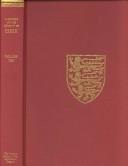
ISBN: 019722721X 0197227708 9780197227213 9780197227701 Year: 1983 Publisher: London Oxford university
Abstract | Keywords | Export | Availability | Bookmark
 Loading...
Loading...Choose an application
- Reference Manager
- EndNote
- RefWorks (Direct export to RefWorks)
Essex (England) --- History --- Essex. Histoire. --- Essex. Geschiedenis. --- 942.6 ESSEX --- 942.6 ESSEX Geschiedenis van Engeland: East Anglia:--reg./lok.--ESSEX --- Geschiedenis van Engeland: East Anglia:--reg./lok.--ESSEX --- Essex, Eng. --- County of Essex (England) --- Bibliography. --- Bibliography --- Essex (England) - Bibliography
Book
ISBN: 9048529603 9789048529605 9789462980341 9462980349 Year: 2019 Publisher: Amsterdam
Abstract | Keywords | Export | Availability | Bookmark
 Loading...
Loading...Choose an application
- Reference Manager
- EndNote
- RefWorks (Direct export to RefWorks)
Transformations of Identity and Society in Anglo-Saxon Essex: A Case Study of an Early Medieval North Atlantic Community presents the results of a comprehensive archaeological study of early medieval Essex (c.AD 400-1066). This region provides an important case study for examining coastal societies of north-western Europe. Drawing on a wealth of new data, the author demonstrates the profound influence of maritime contacts on changing expressions of cultural affiliation. It is argued that this Continental orientation reflects Essex's longterm engagement with the emergent, dynamic North Sea network. The wide chronological focus and inclusive dataset enables long-term socio-economic continuity and transformation to be revealed. These include major new insights into the construction of group identity in Essex between the 5th and 11th centuries and the identification of several previously unknown sites of exchange. The presentation also includes the first full archaeological study of Essex under 'Viking' rule.
Excavations (Archaeology) --- Archaeological digs --- Archaeological excavations --- Digs (Archaeology) --- Excavation sites (Archaeology) --- Ruins --- Sites, Excavation (Archaeology) --- Archaeology --- Essex (England) --- Essex, Eng. --- County of Essex (England) --- Antiquities. --- Anglo-Saxons --- Saxons --- History. --- Anglo-Saxon, Archaeology, Trade, Identity, Essex.
Multi
ISBN: 9781787447813 9781783276806 Year: 2022 Publisher: Woodbridge Boydell Press
Abstract | Keywords | Export | Availability | Bookmark
 Loading...
Loading...Choose an application
- Reference Manager
- EndNote
- RefWorks (Direct export to RefWorks)
An exploration of small early folk communities prior to the eleventh century, showing their development and sophistication. All communities have a strong sense of identity with the area in which they live, which for England in the early medieval period manifested itself in a series of territorial entities, ranging from large kingdoms down to small districts known as pagi or regiones. This book investigates these small early folk territories, and the way that they evolved into the administrative units recorded in Domesday, across an entire kingdom - that of the East Saxons (broadly speaking, what is now Essex, Middlesex, most of Hertfordshire, and south Suffolk). A wide range of evidence is drawn upon, including archaeology, written documents, place-names and the early cartographic sources. The book looks in particular at the relationship between Saxon immigrants and the native British population, and argues that initially these ethnic groups occupied different parts of the landscape, until a dynasty which assumed an Anglo-Saxon identity achieved political ascendency (its members included the so-called "Prittlewell Prince", buried with spectacular grave-good in Prittlewell, near Southend-on- Sea in southern Essex). Other significant places discussed include London, the seat of the first East Saxon bishopric, the possible royal vills at Wicken Bonhunt near Saffron Walden and Maldon, and St Peter's Chapel at Bradwell-on-Sea, one of the most important surviving churches from the early Christian period.
Anglo-Saxons --- Essex (England) --- Antiquities. --- Saxons --- Essex, Eng. --- County of Essex (England) --- History of the United Kingdom and Ireland --- anno 500-1199 --- anno 400-499 --- Suffolk --- Essex --- Great London --- Hertfordshire
Book
ISBN: 1783276800 1787447812 Year: 2022 Publisher: Woodbridge : Boydell Press,
Abstract | Keywords | Export | Availability | Bookmark
 Loading...
Loading...Choose an application
- Reference Manager
- EndNote
- RefWorks (Direct export to RefWorks)
An exploration of small early folk communities prior to the eleventh century, showing their development and sophistication. All communities have a strong sense of identity with the area in which they live, which for England in the early medieval period manifested itself in a series of territorial entities, ranging from large kingdoms down to small districts known as pagi or regiones. This book investigates these small early folk territories, and the way that they evolved into the administrative units recorded in Domesday, across an entire kingdom - that of the East Saxons (broadly speaking, what is now Essex, Middlesex, most of Hertfordshire, and south Suffolk). A wide range of evidence is drawn upon, including archaeology, written documents, place-names and the early cartographic sources. The book looks in particular at the relationship between Saxon immigrants and the native British population, and argues that initially these ethnic groups occupied different parts of the landscape, until a dynasty which assumed an Anglo-Saxon identity achieved political ascendency (its members included the so-called "Prittlewell Prince", buried with spectacular grave-good in Prittlewell, near Southend-on- Sea in southern Essex). Other significant places discussed include London, the seat of the first East Saxon bishopric, the possible royal vills at Wicken Bonhunt near Saffron Walden and Maldon, and St Peter's Chapel at Bradwell-on-Sea, one of the most important surviving churches from the early Christian period.
Anglo-Saxons --- Saxons --- Essex (England) --- Antiquities. --- Essex, Eng. --- County of Essex (England) --- Anglo-Saxon identity. --- East Saxon Kingdom. --- archaeological remains. --- early folk communities. --- historical context. --- native British population. --- pagi. --- regiones. --- shire system. --- territorial entities. --- territorial evolution.
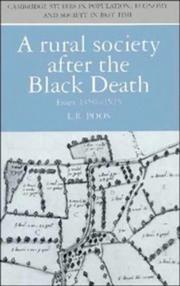
ISBN: 0521382602 0521531276 0511522436 0511876807 9780521382601 9780511522437 9780521531276 Year: 1991 Volume: 18 Publisher: Cambridge Cambridge University Press
Abstract | Keywords | Export | Availability | Bookmark
 Loading...
Loading...Choose an application
- Reference Manager
- EndNote
- RefWorks (Direct export to RefWorks)
A Rural Society after the Black Death is a study of rural social structure in the English county of Essex between 1350 and 1500. It seeks to understand how, in the population collapse after the Black Death (1348-1349), a particular economic environment affected ordinary people's lives in the areas of migration, marriage and employment, and also contributed to patterns of religious nonconformity, agrarian riots and unrest, and even rural housing. The period under scrutiny is often seen as a transitional era between 'medieval' and 'early-modern' England, but in the light of recent advances in English historical demography, this study suggests that there was more continuity than change in some critically important aspects of social structure in the region in question. Among the most important contributions of the book are its use of an unprecedentedly wide range of original manuscript records (estate and manorial records, taxation and criminal-court records, royal tenurial records, and the records of church courts, wills etc.) and its application of current quantitative and comparative demographic methods.
Black Death --- History --- Essex (England) --- England --- Social conditions --- History. --- 1066-1485 --- 16th century --- Black death --- Essex (England) - History. --- Essex (England) - Social conditions. --- England - Social conditions - Medieval period, 1066-1485. --- England - Social conditions - 16th century. --- Black death - England - Essex - History. --- Arts and Humanities --- Black Death - England - Essex - History --- Essex (England) - History --- Essex (England) - Social conditions --- England - Social conditions - 1066-1485 --- England - Social conditions - 16th century --- Social conditions. --- Epidemics --- Medicine, Medieval --- Plague --- Essex, Eng. --- County of Essex (England)
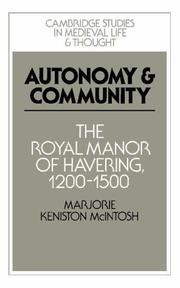
ISBN: 0521320186 0521526094 0511560281 Year: 1986 Volume: 5 Publisher: Cambridge : Cambridge University Press,
Abstract | Keywords | Export | Availability | Bookmark
 Loading...
Loading...Choose an application
- Reference Manager
- EndNote
- RefWorks (Direct export to RefWorks)
This history of the English royal manor of Havering, Essex, illustrates life at one extreme of the spectrum of personal and collective freedom during the later Middle Ages, revealing the kinds of patterns which could emerge when medieval people were placed in a setting of unusual independence. As residents of a manor held by the crown, they profited from royal administrative neglect. As tenants of the ancient royal demesne, they had special legal rights and economic privileges. Havering's dominant families controlled the legal and administrative life of their community through the powerful manor court. The tenants combined effectively to prevent outside interference in their affairs, despite the individualistic self-interest manifest in their economic dealings. In 1465 the tenants obtained a royal charter which established Havering as a formal Liberty, with its own justices of the peace. By the end of the fifteenth century Havering displayed many characteristics commonly associated with the Elizabethan and Jacobean periods.
Feudalism --- -Land tenure --- -Manors --- -Dwellings --- Real property --- Village communities --- Agrarian tenure --- Feudal tenure --- Freehold --- Land ownership --- Land question --- Landownership --- Tenure of land --- Land use, Rural --- Land, Nationalization of --- Landowners --- Serfdom --- Civilization, Medieval --- Land tenure --- Land use --- Chivalry --- Estates (Social orders) --- Case studies --- History --- -History --- -England --- England --- Essex (England) --- -Havering (London, England) --- -Economic conditions --- -Social conditions --- -Case studies --- Manors --- Dwellings --- Havering (London, England) --- Havering, Eng. --- London Borough of Havering (England) --- Essex, Eng. --- County of Essex (England) --- Economic conditions --- Social conditions --- History. --- Grondbezit. Essex. 1200-1500. --- Feodalisme. Essex. 1200-1500. --- Havering [Seigneurie]. Histoire économique et sociale. 1200-1500. --- Propriété foncière. Essex. 1200-1500. --- Féodalité. Essex. 1200-1500. --- Havering [Heerlijkheid]. Economisch en sociale geschiedenis. 1200-1500. --- Arts and Humanities
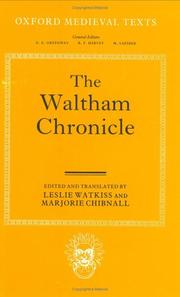
ISBN: 0198221649 9780198221647 Year: 1994 Volume: *28 Publisher: Oxford : Clarendon Press,
Abstract | Keywords | Export | Availability | Bookmark
 Loading...
Loading...Choose an application
- Reference Manager
- EndNote
- RefWorks (Direct export to RefWorks)
Holy Cross --- Relics --- Sainte Croix --- Reliques --- Legends --- History --- Sources --- Légendes --- Histoire --- Harold, --- Death and burial --- Mort et sépulture --- Waltham Abbey (England) --- Waltham, Abbaye de (Angleterre) --- Essex (England) --- Great Britain --- Essex (Angleterre) --- Grande-Bretagne --- Church history --- Histoire religieuse --- Anglo-Saxons --- Sources. --- Legends. --- -Anglo-Saxons --- -Saxons --- Relics and reliquaries --- Bones --- Religious articles --- -Sources --- Harold King of England --- -Death and burial --- -History --- Légendes --- Harold --- Mort et sépulture --- -Relics and reliquaries --- -Waltham Abbey, Eng. --- Waltham Abbey (Essex) --- Saxons --- History&delete& --- Harold Godwineson, --- Harold Godwinson, --- Haroldus, --- Waltham Abbey, Eng. --- Essex, Eng. --- County of Essex (England) --- Church history. --- Anglo-Saxon period, 449-1066 --- Norman period, 1066-1154 --- Great Britain - History - Anglo-Saxon period, 449-1066 - Sources. --- Great Britain - History - Norman period, 1066-1154 - Sources. --- Essex (England) - Church history. --- Anglo-Saxons - England - Essex - Sources. --- Relics - England - History - Sources. --- Holy Cross - Legends. --- ANGLETERRE --- VIE INTELLECTUELLE --- LITTERATURE ANGLAISE --- MOYEN AGE --- 1100-1500 (MOYEN-ANGLAIS) --- HISTOIRE --- SOURCES --- Vie intellectuelle
| Listing 1 - 10 of 11 | << page >> |
Sort by
|

 Search
Search Feedback
Feedback About UniCat
About UniCat  Help
Help News
News